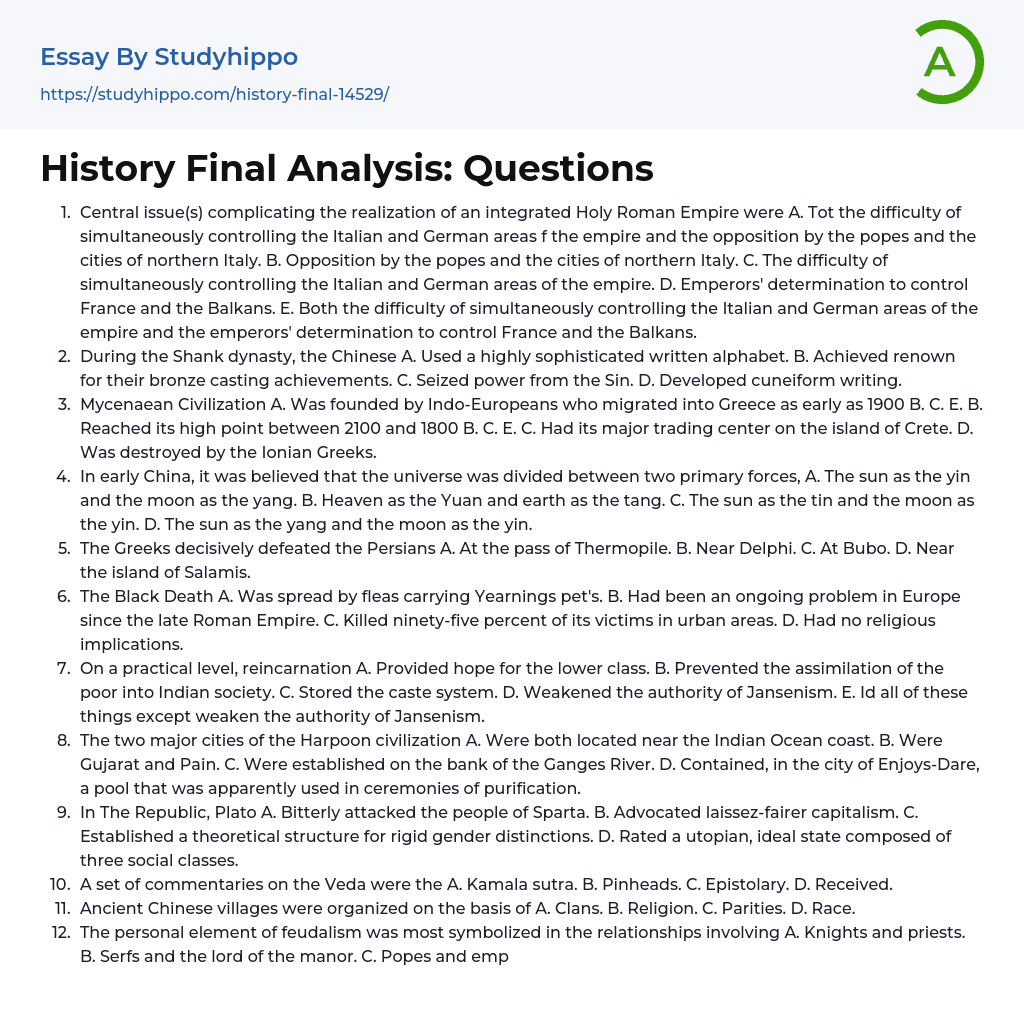- The main obstacles encountered in the pursuit of a unified Holy Roman Empire included:
- The challenge of governing both the Italian and German territories simultaneously, which proved to be arduous.
- Resistance from the popes and cities in northern Italy.
D. Emperors' determination to control France and the Balkans. E. Both the challenge of simultaneously controlling the Italian and German areas of the empire and the emperors' ambition to control France and the Balkans.
The civilization had a highly advanced written language and gained recognition for their exceptional skills in bronze casting. They also overthrew the Sin and assumed control.
D. Cuneiform writ
...ing was developed.
Mycenaean Civilization: A. It was founded by Indo-Europeans who migrated into Greece as early as 1900 B.C.
E. B. reached its peak from 2100 to 1800 B. C. E.
C. The major trading center of Minoan civilization was on the island of Crete and it was destroyed by the Ionian Greeks.
Heaven is represented by the Yuan and earth by the tang. The sun is symbolized as the tin and the moon as the yin.
The sun represents the yang energy, while the moon symbolizes the yin energy.
C. At Bubo an
near the island of Salamis.
Europe has been dealing with this problem since the late Roman Empire, resulting in the death of ninety-five percent of its victims in urban areas.
Reincarnation did not have any religious implications. From a practical standpoint, it offered hope to the lower class and prevented the assimilation of the poor into Indian society. Additionally, it maintained the caste system.
D. Weakened the authority of Jansenism.
E. Did all of these things except weaken the authority of Jansenism.
A. Were both located near the Indian Ocean coast.
B.
Both Gujarat and Pain. C. were established on the banks of the Ganges River.
In the city of Enjoys-Dare, there existed a pool that was used for purification ceremonies. According to reports, this pool served as a venue for such ceremonies.
Plato, in The Republic, openly criticized the people of Sparta and additionally supported laissez-faire capitalism.
The text discusses the establishment of a theoretical framework for rigid gender distinctions and the classification of a utopian state into three social classes. Additionally, it mentions the A. Kamala sutra as a collection of commentaries on the Veda.
Pinheads. C. Epistolary. D. Received. Ancient Chinese villages were organized on the basis of A.
Clans, Religion.
Parities. D. Race.
B. Serfs and the lord of the manor.
C. Popes and emperors.
D. Lords and vassals.
South China meant to keep out nomadic invaders. C.
The construction of this structure took place during the Mining dynasty with the purpose of protecting crops from damage caused by rabbits and wild yaks. It was built in the valleys of the A. Nanjing and Human rivers, being the origin of ancient Chinese civilization.
Indus and Lima rivers, C. Yang and Mekong rivers, D. Yellow and Yang rivers.
- As it prospered, the early Roman Empire A.
Squired people in the entire empire to speak Latin and eliminated the practice of slavery, while also witnessing a decrease in the supply of gold and silver coins in the eastern part of the empire.
D. Witnessed the emergence of a significant disparity between the wealthy and the impoverished.
- Puritans essays
- Afterlife essays
- Buddhism essays
- Christianity essays
- Deism essays
- Faith essays
- God essays
- Hinduism essays
- Islam essays
- Jews essays
- Judaism essays
- Monotheism essays
- New Testament essays
- Ritual essays
- Sin essays
- Soul essays
- Theology essays
- Confession essays
- Devil essays
- Miracle essays
- Monk essays
- Revelation essays
- Atheism essays
- Immortality essays
- Jainism essays
- Sinners essays
- Bible essays
- Old Testament essays
- Salvation essays
- Temple essays
- Taoism essays
- Pilgrimage essays
- Freedom Of Religion essays
- Existence of God essays
- Christian Worldview essays
- Cosmological Argument essays
- Gautama Buddha essays
- Karma essays
- Buddha essays
- Baptism essays
- Holy Spirit essays
- Jesus Christ essays
- Adam And Eve essays
- Crucifixion Of Jesus essays
- Crusades essays
- Eucharist essays
- God The Father essays
- Pope essays
- Protestantism essays
- Christian essays




